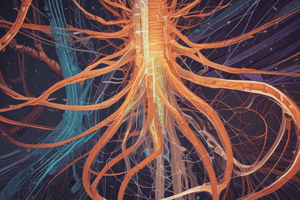Podcast
Questions and Answers
What is the function of the spinoreticular tract mentioned in the text?
What is the function of the spinoreticular tract mentioned in the text?
- Activates the sympathetic nervous system (correct)
- Projects from the ventral horn of the spinal cord to the cerebral hemisphere
- Inhibits muscle contractions
- Activates the parasympathetic nervous system
Where does the rubrospinal tract arise from?
Where does the rubrospinal tract arise from?
- Cerebral hemisphere
- Spinal cord ventral horn
- Midbrain red nucleus (correct)
- Medulla oblongata
Which tract is crucial for voluntary control of most muscles in the body?
Which tract is crucial for voluntary control of most muscles in the body?
- Vestibulospinal tract
- Rubrospinal tract
- Corticospinal tract (correct)
- Medial vestibulospinal tract
What is the main function of the lateral vestibulospinal tract?
What is the main function of the lateral vestibulospinal tract?
Which spinal tract is involved in controlling fine motor movements in the arms and legs?
Which spinal tract is involved in controlling fine motor movements in the arms and legs?
What type of information do spinal tracts convey?
What type of information do spinal tracts convey?
What is the role of the medial vestibulospinal tract in limb movement?
What is the role of the medial vestibulospinal tract in limb movement?
Which neural impulses are primarily involved in muscle tone control?
Which neural impulses are primarily involved in muscle tone control?
What is proprioception related to?
What is proprioception related to?
Which specific tracts within the dorsal columns are responsible for transmitting tactile sensations?
Which specific tracts within the dorsal columns are responsible for transmitting tactile sensations?
Where does the anterior spinothalamic pathway carry pain and temperature sensations from?
Where does the anterior spinothalamic pathway carry pain and temperature sensations from?
In addition to proprioceptive sensations, what other sensory information do dorsal columns transmit?
In addition to proprioceptive sensations, what other sensory information do dorsal columns transmit?
Flashcards are hidden until you start studying
Study Notes
Spinal Tracts
Spinal tracts refer to the specific pathways within the spinal cord through which sensory information travels from peripheral nerve endings to the central nervous system, and motor commands travel from the brain back to the muscles. These pathways play a crucial role in conveying somatic sensation such as touch, pressure, temperature, and pain; as well as visceral sensations that relate to organ function. Additionally, they facilitate the transmission of neural impulses involved in muscle tone control. Here is a more detailed look into the ascending and descending tracts of spinal nerves, their functions, and how they contribute to our overall health and functioning.
Ascending Tracts
Dorsal Columns
The dorsal columns of the spinal cord contain two major tracts - the gracile fasciculus and the cuneate fasciculus. They are responsible for transmitting the majority of proprioceptive and tactile sensations from the body to the brain. Proprioception refers to the awareness of the body's position in space and its movements, while tactile sensation relates to the perception of touch, including light touch, deep pressure sensation, vibratory sense, and position sense.
Anterior Spinothalamic Pathway
Situated near the midline of the anterior part of the lateral spinothalamic tract, the anterior spinothalamic pathway carries pain and temperature sensations from the lower limbs and perineum. It also includes the spinoreticular tract, which projects from the dorsal horn of the spinal cord to the reticular formation, where it activates the sympathetic nervous system. This activation can lead to vasoconstriction, increased heart rate, and other responses known as the stress response.
Descending Tracts
Corticospinal Tracts (CST)
The corticospinal tract consists of the medial and lateral pyramids in the cerebral hemisphere. Their axons descend down through the brainstem to synapse with neurons in the ventral horn of the spinal cord. There, they form the upper motor neuron component of the final motor pathway to skeletal muscles. The corticospinal tract plays a crucial role in the voluntary control of most muscles, glandular tissue, and smooth muscles, as well as in some reflexes.
Rubrospinal Tracts
The rubrospinal tract is a neural pathway that consists of the nucleus ruber and the rubrospinal nerve. It arises from the red nucleus (nucleus ruber) in the midbrain and provides a direct connection between the brainstem and the spinal cord. The rubrospinal tract is involved in the control of fine motor movements in the arms and legs.
Vestibulospinal Tracts
The vestibulospinal tract is a neural pathway that runs from the vestibular nuclei in the medulla oblongata to the spinal cord. It has two components: the lateral and medial vestibulospinal tracts. The lateral vestibulospinal tract provides a major input to the extensor muscles of the limbs, ensuring their activation during movement and walking. The medial vestibulospinal tract, on the other hand, inhibits the contraction of the flexor muscles of the limbs, preventing the limbs from bending during movement.
In conclusion, the spinal tracts, both ascending and descending, play a vital role in the communication between the brain and the rest of the body, allowing us to receive and process sensory information, regulate muscle activity, and coordinate movements. Each tract has its distinct function in ensuring the proper operation of our nervous system.
Studying That Suits You
Use AI to generate personalized quizzes and flashcards to suit your learning preferences.




